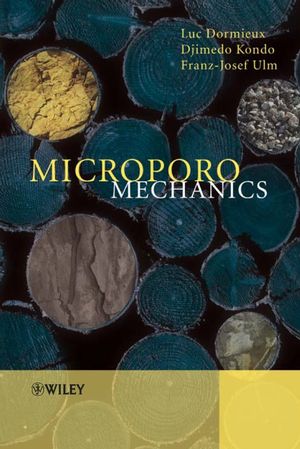MicroporomechanicsISBN: 978-0-470-03188-9
Hardcover
352 pages
August 2006
 This is a Print-on-Demand title. It will be printed specifically to fill your order. Please allow an additional 10-15 days delivery time. The book is not returnable.
|
||||||
Notation.
1. A Mathematical Framework for Upscaling Operations.
1.1 Representative Elementary Volume (rev).
1.2 Averaging Operations.
1.3 Application to Balance Laws.
1.4 The Periodic Cell Assumption.
PART I: MODELING OF TRANSPORT PHENOMENA.
2. Micro(fluid)mechanics of Darcy's Law.
2.1 Darcy's Law.
2.2 Microscopic Derivation of Darcy's law.
2.3 Training Set: Upper and Lower Bounds of the Permeability of a 2-D Microstructure.
2.4 Generalization: Periodic Homogenization Based on Double Scale Expansion.
2.5 Interaction Between Fluid and Solid Phase.
2.6 Beyond Darcy's (Linear) Law.
2.7 Appendix: Convexity of _(d).
3. Micro-to-Macro Diffusive Transport of a Fluid Component.
3.1 Fick's Law.
3.2 Di_usion Without Advection in Steady State Conditions.
3.3 Double Scale Expansion Technique.
3.4 Training Set: Multilayer Porous Medium.
3.5 Concluding Remarks.
PART II: MICROPOROELASTICITY.
4. Drained Microelasticity.
4.1 1-D Thought Model: The Hollow Sphere.
4.2 Generalization.
4.3 Estimates of the Homogenized Elasticity Tensor.
4.4 Average and E_ective Strains in the Solid Phase.
4.5 Training Set: Molecular Di_usion in a Saturated Porous Medium.
5. Linear Microporoelasticity.
5.1 Loading Parameters.
5.2 1-D Thought Model: The Saturated Hollow Sphere Model.
5.3 Generalization.
5.4 Application: Estimates of the Poroelastic Constants and Average Strain Level.
5.5 Levin's Theorem in Linear Microporoelasticity.
5.6 Training Set: The Two-Scale Double-Porosity Material.
6. Eshelby's Problem in Linear Diffusion and Microporoelasticity.
6.1 Eshelby's Problem in Linear Diffusion.
6.2 Eshelby's Problem in Linear Microelasticity.
6.3 Implementation of Eshelby's Solution in Linear Microporoelasticity.
6.4 Instructive exercise: Anisotropy of Poroelastic Properties Induced by Flat Pores.
6.5 Training Set : New estimates of the homogenized diffusion tensor.
6.6 Appendix: Cylindrical Inclusion in an Isotropic Matrix.
PART III: MICROPOROINELASTICITY.
7. Strength Homogenization.
7.1 1-D Thought Model: Strength Limits of the Saturated Hollow Sphere.
7.2 Macroscopic Strength of an Empty Porous Material.
7.3 Von Mises Behavior of the Solid Phase.
7.4 The Role of Pore Pressure on the Macroscopic Strength Criterion.
7.5 Non Linear Microporoelasticity.
8. Non-Saturated Microporoomechanics.
8.1 The E_ect of Surface Tension at the Fluid-Solid Interface.
8.2 Microporoelasticity in Unsaturated Conditions.
8.3 Training Set: Drying Shrinkage in a Cylindrical Pore Material System.
8.4 Strength Domain of Non-Saturated Porous Media.
9. Microporoplasticity.
9.1 1-D Thought Model: The Saturated Hollow Sphere.
9.2 State Equations of Microporoplasticity.
9.3 Macroscopic Plasticity Criterion.
9.4 Dissipation Analysis.
10. Microporofracture and Damage Mechanics.
10.1 Elements of Linear Fracture Mechanics.
10.2 Dilute Estimates of Linear Poroelastic Properties of Cracked Media.
10.3 Mori-Tanaka Estimates of Linear Poroelastic Properties of
Cracked Media.
10.4 Micromechanics of Damage Propagation in Saturated Media.
10.5 Training Set: Damage Propagation in Undrained Conditions.
10.6 Appendix : Algebra for Transverse Isotropy and Applications.
References.
Index.



